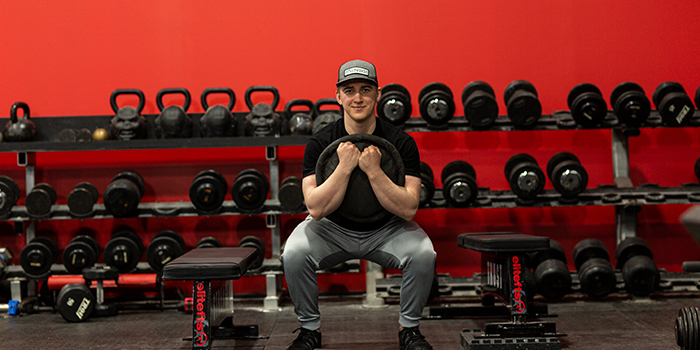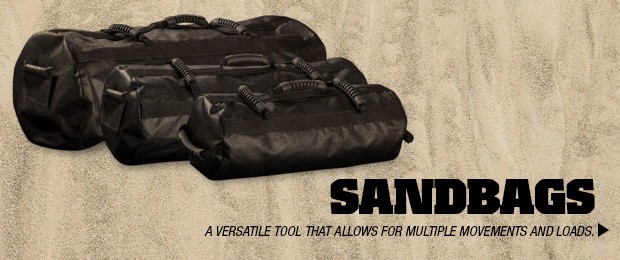
Originally published in October of 2010
Sure, this may seem like the perfect opportunity to write a fancy little infomercial. I wouldn’t blame you if you didn’t want to believe a word I’m about to say. However, after five years of working with elite coaches around the world in a variety of very different sports, I hope you can keep an open mind.
I know—it’s easy in this internet age to be leery of anything that talks specifically about an implement. Yet, if I’ve learned one thing working with all these awesome coaches, it’s that the successful ones are those who can maintain an open mind while being critical of new ideas. Heck, if coaches like Steven Morris use some of these concepts in training elite football players, there just might be something to it!
What is it? Sandbags. Yes, sandbags. Nothing new for many coaches but always used as a tool when “better” training implements weren’t available. Others used it to be “hardcore,” but training hard doesn’t guarantee results. Just as with any other training method or implement, there should be very specific ways and reasons to use sandbags. There aren’t any groups that could benefit more from the use of sandbags than athletes.
Reason 1: Remove the Excuses
There might not be anything more entertaining than the endless debates over whether or not Olympic lifts are valuable. Most coaches don’t argue the validity of their effectiveness. The major sticking point tends to be the ability to teach and acquire the skills to do them well.
The major benefit to Olympic lifting is the triple extension it teaches, which is the same power production pattern used in most powerful sporting activities. One can’t deny this to be important, but the flexibility and skills required in Olympic weightlifting often makes it a bastardized form of training. Sandbags come into play as a very simple implement that can be used to learn the same triple extension without the problem of flexibility or high skill requirements.
Even better, the sandbag is quite different from a barbell. On the bar, the weight is evenly loaded. With a sandbag, the weight is all at the bottom. That means the lifter spends more time trying to accelerate the weight because the sandbag drops away from the lifter as he tries to perform the movement. More time accelerating and more power production!
Reason 2: Get Out of the “Safe” Zone
Funny how so many coaches argue over the small things but often miss the bigger picture problems in their training. Ask any strength coach if his training is “athletic” and undoubtedly he will give a strong, “Hell yeah!” Is it really though?
Seeing so many different programs from mixed martial arts to American football to hockey, it’s often disappointing how unathletic these programs appear. The majority of the lifts take place in strong and stable positions (i.e. squat, deadlift, even pressing), but sport is dynamic and unpredictable, and if anything, not perfect!
I never wanted to give too much credence to the idea of doing many of the “strength” movements in other positions because it appeared to be more of a circus trick than anything. It may have been I just wasn’t comfortable trying to do such things with the tools I had available. After an injury forced me to think outside of my comfort zone, I was shocked at how weak I was when I wasn’t in my strong base of support.
Sandbags come into play because they are the perfect implement to try to perform these different positional strength lifts. Barbells can be awkward and dangerous, and dumbbells and kettlebells don’t move as well. The sandbag allows us to pull, press, and squat and do a host of other standard movements in a variety of stances, loading positions, and angles. This is what most coaches call “filling in the holes” of their training programs—moving in positions and postures that are common in sport but that we neglect in the weight room.
Reason 3: You Can Get Scary Strong
It seems odd object lifting has really become the new buzz type of training. As most of us know, there isn’t anything new. What has attracted so many serious athletes to this form of training is the history of great strength that has been known to be achieved with odd objects.
We all know the stories of “farm boy strength,” or have heard of those who worked manual labor jobs for years and possess strength that would make most gym goers envious. Even great legendary Strongmen such as Arthur Saxon used these ideas as well. Listen to what strongman, Bud Jeffries, had to say about Saxon and his training with odd objects:
“But it is not the barbell alone that made him strong. He talks often about wrestling as part of his training and in fact wrestled much of the time professionally along with being a Strongman in his career. He also did lots of heavy, odd object lifting including challenge sandbags as part of his Strongman act.”
Other more current strength legends such as Brooks Kubik also believed in the power of sandbag training and odd objects:
“Sandbags are the very best training tool for combat athletes.”
Pretty simple and direct but hard to argue. What is it that makes sandbags help even the best lifters get strong? First, the obvious weight shift of the sandbag completely alters the lifter’s comfort and ability to get grooved into an exercise. Everyone notices quickly that they’re hitting muscles that just feel foreign to them.
A heavily underrated aspect of sandbag training is the nine different holding positions that allow us to load the body in ways that previously weren’t very possible. In most of these positions, we aren’t just letting the weight sit on our body, but we have to resist altering posture and use often our upper and lower body at the same time. There simply isn’t any rest!
Don’t believe me? Go for a heavy sandbag carry. Put it on your shoulder, hold it bear hug style, and hold it in a Zercher position. Here is the trick though—don’t alter your body posture. Try to keep yourself from tilting, twisting, and getting into altered body positions. You will see how your deep muscles just scream for mercy.
It should be the goal of every coach and athlete to spend time training versus learning how to train. With more and more time, limited by skill camps, sport coaches, club teams, and other programs, we as coaches can’t have the luxury of wasting time on methods or ideas that sound good in theory but simply aren’t practical to the real world of training athletes!











1 Comment